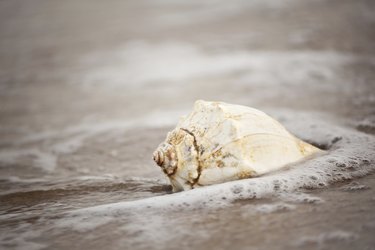
You won't find many shells along the resort area of Virginia Beach -- resort crews rake the sand every morning before dawn. Take a stroll up to the north end or drive down the coast to Sandbridge for better shell-hunting luck. Better yet, jump in the car and visit one of the state's best shell-hunting beaches, found from 5 to 100 miles from the busy tourist beach.
By the Bucketful
You can collect up to a gallon of seashells during each visit to Assateague Island National Seashore in the northernmost part of the state. Famous for its wild ponies, the island harbors more than a dozen varieties of shells ranging from whelks to moon shells. For the best shell-hunting, head to the beach in the winter months after a nor'easter rages through the area. Access the island in Virginia by foot or bike from Chincoteague Island via a paved pathway.
In Historic Haunts
Although it's in the state's most populated city of Virginia Beach, False Cape State Park sets aside 4,300 acres of secluded natural terrain accessible only by foot, bike, boat or tram. Wash Woods -- once a community of shipwreck survivors -- has only a church and cemetery left to mark its existence. Shells lie scattered across the graves beneath the Spanish moss. You can also play the park's geocaching game, in which you must arrange native seashells in the right order to find the next clue. Wander along the park's shoreline to find cockleshells, moon snails, baby's ear shells and several varieties of whelks.
Where Settlers First Set Foot
First Landing State Park in Virginia Beach marks the original landing site of Jamestown's settlers. There's also an Indian burial site at the park commemorating Chesapeake Indians who lived at the location. Over the seasons, people have left shells -- an important commodity to the Indians -- on fence posts as little mementos or tributes. You can find shells to leave at the site or take with you along the park's beach. Oyster shells, moon snails, sand dollars and whelks are common in the area. Enjoy beach combing for days by staying at the park's campground, which has electric and water hookups for tents and RVs. The park also has 20 modern cabins with one or two bedrooms.
More Than a Grand View
At Hampton's Grandview Nature Preserve, the churning action of waves, long-shore currents and tides work together with the erosive action of the Back and York Rivers to provide unusual shells and other finds to the hardy beachcomber. You'll find the most shells along the wrack line in winter following a big storm. The powerful storm waves deposit some of the biggest and heaviest items brought in by the tide. Look for blood ark shells, slipper shells and whelks as well as angel wing, jackknife, razor and quahog clam shells.